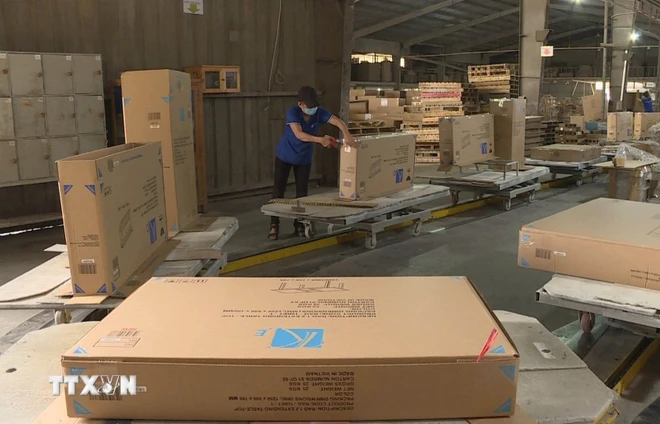Vietnam’s wood industry is recovering positively, entering a period of transformation. Not only expanding its commercial position, wood enterprises are also gradually asserting themselves in terms of technology, green production and sustainable development.
With a growth rate of nearly 21%, the export value of wood and wood products reached 13.18 billion USD in 10 months, the wood processing export industry is expecting to bring in 15.5-16 billion USD this year.
The United States is Vietnam's largest consumer market for wood and wood products, accounting for over 50% of the market share. China and Japan are the next two largest markets.
Compared to the same period last year, the export value of wood and wood products to the US and China markets both grew strongly with double digits; only the Japanese market increased slightly.
Among the 15 main export markets, the export value of wood and wood products increased the most in Spain with an increase of over 63%.
Seizing the opportunity of positive market recovery signals, some major export products all increased quite well, such as wood chips (up nearly 38%), wood and wood products (up over 20%).
Associations, unions, and wood and forestry processing enterprises have made efforts and been proactive in production as well as seeking export markets.
Orders of Hai Duong MDF Construction and Production Company Limited increased by about 50% compared to the same period last year.
Mr. Pham Anh Duong, Director of Hai Duong MDF Construction and Production Limited Company (Vinamdf) happily said that the company has orders until the first quarter of 2025.
As for Ke Go Limited Liability Company, the business also struggled with many difficulties after 2 years of the COVID-19 pandemic, but this year orders have grown again.
Mr. Trinh Xuan Duong, Director of Ke Go Limited Liability Company said that the market will stabilize and develop.
Plywood, pellets, and wood chip products in 2024 will grow by 25-30%.
Vietnam's plywood markets are mainly the United States, Japan, and Malaysia; pellets are mainly exported to Japan and South Korea, while the main market for Vietnam's wood chips is China.
With risks from the market, any business will have to adapt quickly, speed up data analysis as well as handle situations. Typically, the trend of circular production and consumption, businesses must change to adapt to these changes. Or the strong shift in product structure with the launch of many products with practical applications in life.
In 2025, the enterprise will focus on developing raw materials and certified forests, and at the same time, develop a plan to expand production. After a period of fluctuations in politics , markets, interest rates, etc., Mr. Nguyen Liem, Chairman of the Binh Duong Wood Processing Association (BIFA), assessed that these issues are showing signs of improvement, inventories are decreasing, while global demand for wood products is not decreasing.
The increase in exports shows that global consumption demand is recovering and Vietnamese products are increasingly meeting international standards.
Mr. Do Xuan Lap, Chairman of the Vietnam Timber and Forest Products Association, shared that FDI enterprises are both good at production and good at the market, while Vietnamese enterprises are only good at production, but weak at the market and trade promotion stages.

FDI enterprises open companies, warehouses, offices, and stores in large markets; market work is very complete. Vietnam's wood industry is aiming for this. Associations and enterprises promoting market and trade promotion will help raise the role of Vietnamese enterprises compared to FDI enterprises.
According to Mr. Do Xuan Lap, there are more and more specialized exhibitions and trade promotions, and many businesses in other fields related to the industry also participate in trade promotion of wood industry businesses.
At the same time, in the future there will be many plans for fairs in major cities, key locations of the wood industry that will promote the development and growth of the industry. However, Vietnamese wood products exported to the US market will continue to be at risk of facing anti-dumping and anti-subsidy investigations by the US.
According to Mr. Do Xuan Lap, the best way to improve the "health" of the wood industry is technical solutions, improving technology in production; moving towards green production, reducing emissions.
At the same time, promote trade, develop markets, develop designs, and improve the quality of Vietnamese wooden furniture. Along with that, there are solutions for business management; in which, prioritize digital transformation.
Faced with challenges facing the wood processing and export industry, Mr. Tran Quang Bao, Director of the Forestry Department, said that it is necessary to promote, introduce, and promote trade in the wood processing industry, especially through specialized fairs and exhibitions.
In particular, to prepare legal and quality raw materials for the export wood processing industry, the Ministry of Agriculture and Rural Development will continue to implement policies to encourage the development of large timber, timber with sustainable forest management certification, and develop cooperation and linkage in planting production forests associated with the consumption of forest products.
The Ministry of Agriculture and Rural Development is piloting the issuance of codes for raw material forest growing areas in the provinces of Bac Giang, Lang Son, Phu Tho, Tuyen Quang and Yen Bai.
After that, a large-scale assessment will be conducted to gradually provide timber from legal sources to meet the requirements of the international market, especially the EU's Anti-Deforestation Regulation (EUDR)./.
(Vietnam+)
Source: https://www.vietnamplus.vn/xuat-khau-go-cua-ca-nuoc-du-kien-thu-ve-16-ty-usd-trong-nam-nay-post998704.vnp


![[Photo] Readers line up to visit the photo exhibition and receive a special publication commemorating the 135th birthday of President Ho Chi Minh at Nhan Dan Newspaper](https://vphoto.vietnam.vn/thumb/1200x675/vietnam/resource/IMAGE/2025/5/17/85b3197fc6bd43e6a9ee4db15101005b)

![[Photo] Prime Minister Pham Minh Chinh chairs meeting on science and technology development](https://vphoto.vietnam.vn/thumb/1200x675/vietnam/resource/IMAGE/2025/5/17/ae80dd74c384439789b12013c738a045)
![[Photo] More than 17,000 candidates participate in the 2025 SPT Competency Assessment Test of Hanoi National University of Education](https://vphoto.vietnam.vn/thumb/1200x675/vietnam/resource/IMAGE/2025/5/17/e538d9a1636c407cbb211b314e6303fd)





























![[Photo] Nearly 3,000 students moved by stories about soldiers](https://vphoto.vietnam.vn/thumb/1200x675/vietnam/resource/IMAGE/2025/5/17/21da57c8241e42438b423eaa37215e0e)
































































Comment (0)